

Self-Guided Campus Tour

Follow our map through our favorite places and get a feel for student life.
Take control of your visit with our self-guided tour, giving you the freedom to explore Carnegie Mellon University at your own pace. Whether you're discovering cutting-edge academic facilities, vibrant student spaces or picturesque outdoor areas, this tour lets you focus on what interests you most. With an easy-to-follow map and engaging highlights, you'll immerse yourself in the distinctive atmosphere of CMU and gain a deeper understanding of what makes this university exceptional. Start your journey at any time, and experience campus on your own terms.
Key Campus Stops
Explore some of the locations at the heart of our campus community. Experience student life at the Cohon University Center or stop by the legendary Fence, the unofficial message board for the Carnegie Mellon community. Visit the Scotty Statue, a popular photo spot, and check out the University Store for CMU gear. Discover the hands-on innovation in one of our makerspaces, or find a quiet study nook in the library.

Coulter Welcome Center
Welcome to Carnegie Mellon University — we are excited to have you visit our campus! The Coulter Welcome Center was founded in 2018 by the generous donation of David and Susan Coulter to create a front door to campus that serves as a one-stop destination for all visitors.

Tepper Quad
This facility is a 315,000 square foot state-of-the-art building, home to the Tepper School of Business, the Coulter Welcome Center, fitness center, dining locations, JPMorgan Chase & Co. AI Maker Space and the Swartz Center for Entrepreneurship.

Gates and Hillman Centers
The Gates Centers for Computer Science and Hillman Center for Future Technologies are Gold LEED Certified Centers and home to the School of Computer Science. They were made possible by lead gifts from the Bill and Melinda Gates and the Henry L. Hillman foundations.

Warner Hall
This building is home to the Office of Undergraduate Admission on the 2nd floor. The HUB and Enrollment Services also reside on the lower level, which is where you get your Student ID if you choose to attend CMU.

Purnell Center for the Arts
This facility is home to our School of Drama, the nation's oldest degree-granting drama program, and includes state-of-the-art performance and education facilities like the Philip Chosky Theater and the Regina Gouger Miller Gallery.

Randy Pausch Bridge
This bridge connects one of the university's fine arts buildings, Purnell Center, with the home for computer science, the Gates & Hillman Centers. The bridge was named after CMU alumnus and professor Randy Pausch who inspired millions through his "Last Lecture".

The Fence
The Fence sits in the middle of campus and acts as a rotating billboard for student groups. Painting The Fence is a time-honored CMU tradition. It may only be painted by CMU students between midnight and sunrise, in its entirety, and using only paint brushes. To keep their message on display, The Fence must be guarded by two students for as long as they'd like it to remain.

Doherty Hall
This facility contains some of the largest lecture-style classrooms and lab spaces for our Mellon College of Science students, in addition to lab and studio spaces for departments like Engineering, Chemistry, Biology and Art.

Hamerschlag Hall
This facility is home to Electrical & Computer Engineering. The rotunda is one of the most iconic images on campus while also boasting a rainwater garden green roof.

ANSYS Hall
This facility is a four-story, mixed-use building that incorporates TechSpark, a maker assembly space, with access to the outdoor Maker Courtyard, student collaboration spaces, classrooms and offices.

Scaife Hall
The Alan Magee Scaife Hall of Engineering is a 85,000 square-foot building comprised of labs, a drone arena, offices, classrooms and a café. The building is the home for the Mechanical Engineering Department.

Baker Hall
This facility is one of the oldest buildings on campus and connects to Porter Hall via a long, sloped hallway. Baker is home to the Dietrich College of Humanities and Social Sciences.

University Libraries
Hunt Library opened in 1961 as the university's first dedicated library building and was a gift from Roy and Rachel Hunt. It's the largest of the four libraries on campus. It also houses facilities for the Integrative Design, Arts and Technology (IDeATe) program.

College of Fine Arts Building
This facility is an architectural creation of Henry Hornbostel, the college's first dean, and is home to three of its five schools: architecture, art and music — as well as four BXA intercollege degree programs: the bachelor of humanities & arts, science & arts, computer science & arts and engineering & arts.

Posner Hall
This facility houses the Student Academic Success Center that focuses on creating spaces for students to engage in their coursework through options like academic coaching, subject-specific tutoring, effective communication strategies and accommodations for students with disabilities. It's adjacent to the Hall of the Arts, which is home to some teaching and rehearsal spaces for the School of Music.

Margaret Morrison Carnegie Hall
This building hosts facilities for the schools of Architecture and Design. Originally named Margaret Morrison Carnegie College, it opened in 1906 as a vocational school for women.

Highmark Center for Health, Wellness and Athletics
This 160,000 square-foot building opened in fall 2024 and unifies robust health services, contemporary facilities and educational programs that support students' minds, bodies and spirits in a comprehensive care model. It also includes a modern athletics facility.

The Hill
This residence hall neighborhood offers first-year living. University Housing consists of 26 residence halls, apartments and house communities throughout campus.

Gesling Stadium
This facility is home to our football and track and field teams, which are part of the 19 DIII varsity athletics teams we have on campus. This location typically holds the university's commencement ceremonies.

Cohon University Center (CUC)
This facility is our student union where the community can take advantage of the fitness facilities, catch a show at the black-box theater, visit the chapel, post office, ATM or get lunch in one of the many eateries. The CUC is home to The Center for Student Diversity and Inclusion, which offers resources to enhance an inclusive and transformative student experience focused on access, success, campus climate and intergroup dialogue. campus. This location typically holds the university's commencement ceremonies.

University Store
Located in the Cohon University Center, the University Store sells branded university merchandise. While the store does not carry traditional textbooks, they can assist students in finding course materials. Located on the lower level, the Art Store carries art supplies for students and casual hobbyists.

Walking to the Sky
This 100-foot-tall, seven-ton sculpture was created by internationally renowned alumnus Jonathan Borofsky and serves as a centerpiece of campus. The installation was made possible by Carnegie Mellon trustee and CMU alumna Jill Kraus and her husband, Peter. According to Borofsky, the sculpture is a "celebration of the human potential for discovering who we are and where we need to go."